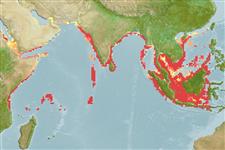Elasmobranquios (tiburones y rayas) (sharks and rays) >
Rhinopristiformes (Shovelnose rays) >
Glaucostegidae (Giant guitarfishes)
Eponymy: André Thouin (1746–1824) was a French botanist and a colleague of Lacépède’s at Le Jardin des Plantes (Muséum Nationale d’Histoire Naturelle), Paris. [...] (Ref. 128868), visit book page.
Environment: milieu / climate zone / depth range / distribution range
Ecología
marino bentopelágico; rango de profundidad ? - 60 m (Ref. 114953). Tropical; 28°N - 10°S, 33°E - 120°E (Ref. 114953)
Distribución
Países | Áreas FAO | Ecosistemas | Ocurrencias, apariciones | Point map | Introducciones | Faunafri
Indo-West Pacific: Red Sea, India (including Sri Lanka) to Indonesia, north to Japan (Ref. 114953). Australian and old records from the Mediterranean Sea and Suriname need confirmation.
Tamaño / Peso / Age
Maturity: Lm ? range ? - ? cm
Max length : 300 cm TL macho / no sexado; (Ref. 58048)
Found inshore (Ref. 9909) and offshore (Ref. 58784). A carnivorous fish that feeds on large shellfishes (Ref. 58784). Ovoviviparous (Ref. 50449). Biology little known (Ref. 9909). Caught occasionally by demersal tangle net fisheries operating throughout the area. Utilized for its meat, find (both very high value), skin and cartilage (Ref.58048). Marketed fresh and probably dried-salted (Ref. 9909).
Life cycle and mating behavior
Madurez | Reproducción | Puesta | Huevos | Fecundidad | Larva
Exhibit ovoviparity (aplacental viviparity), with embryos feeding initially on yolk, then receiving additional nourishment from the mother by indirect absorption of uterine fluid enriched with mucus, fat or protein through specialised structures (Ref. 50449).
Compagno, L.J.V., 1999. Checklist of living elasmobranchs. p. 471-498. In W.C. Hamlett (ed.) Sharks, skates, and rays: the biology of elasmobranch fishes. Johns Hopkins University Press, Maryland. (Ref. 35766)
IUCN Red List Status (Ref. 130435: Version 2024-2)
Threat to humans
Harmless
Human uses
Pesquerías: comercial
Herramientas
Special reports
Download XML
Fuentes de Internet
Estimates based on models
Preferred temperature (Ref.
123201): 24.8 - 29.1, mean 28.1 °C (based on 1958 cells).
Phylogenetic diversity index (Ref.
82804): PD
50 = 0.5156 [Uniqueness, from 0.5 = low to 2.0 = high].
Bayesian length-weight: a=0.00363 (0.00143 - 0.00920), b=3.09 (2.87 - 3.31), in cm total length, based on LWR estimates for this (Sub)family-body shape (Ref.
93245).
Nivel trófico (Ref.
69278): 3.5 ±0.37 se; based on food items.
Resiliencia (Ref.
120179): Bajo, población duplicada en un tiempo mínimo de 4.5-14 años (Fec assumed to be <100).
Fishing Vulnerability (Ref.
59153): Very high vulnerability (90 of 100).
